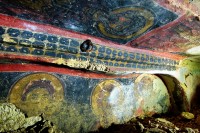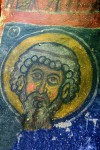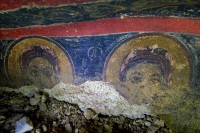 Archaeologists excavating the vast networks of rock-cut caves underneath the massive Byzantine-era castle in the town of Nevşehir, Central Anatolia Region, Turkey, have discovered an ancient church with unique frescoes depicting Biblical scenes not seen before in other churches of the period. Preliminary estimates suggest the church dates to the 5th century and the frescoes that have been revealed so far — on the ceiling and very tops of the walls — are still in brilliant color. There are scenes of Jesus’ crucifixion, the Ascension, saints and Old Testament prophets including Moses and Elijah.
Archaeologists excavating the vast networks of rock-cut caves underneath the massive Byzantine-era castle in the town of Nevşehir, Central Anatolia Region, Turkey, have discovered an ancient church with unique frescoes depicting Biblical scenes not seen before in other churches of the period. Preliminary estimates suggest the church dates to the 5th century and the frescoes that have been revealed so far — on the ceiling and very tops of the walls — are still in brilliant color. There are scenes of Jesus’ crucifixion, the Ascension, saints and Old Testament prophets including Moses and Elijah.
Nevşehir Mayor Hasan Ünver said the frescoes in the church showed the rise of Jesus the Christ into the sky and the killing of the bad souls.
“We know that such frescoes have so far never been seen in any other church,” Ünver said[….]
“It is reported that some of the frescoes here are unique. There are exciting depictions like fish falling from the hand of Jesus Christ, him rising up into the sky, and the bad souls being killed.”
That reference to bad souls being killed is not clear to me. It could be the Last Judgement, I suppose, but the souls of the wicked are damned, not killed. They wish they were killed! That’s kind of the whole point of Hell. I wonder if it’s a reference to the Harrowing of Hell derived from 1 Peter 3:19-20 that refers to Jesus preaching to evil souls/spirits (ie, Luciferian demons, rather than the souls of dead people) imprisoned in Limbo/Hell/Hades. It was a popular theme in Orthodox art. In fact, it first appears in Orthodox art significantly earlier than in Catholic art. The Western tradition appears to have only begun to borrow it from the Orthodox in the 8th century.
 The underground city of Nevşehir was first unearthed in 2014 and while several other towns in the region, most famously Göreme, are known for their ancient rock-cut tunnel systems, the one in Nevşehir is believed to be the largest covering an area of 360,000 square meters with some tunnels more than four miles long. People have been beehiving under this place for an estimated 5,000 years. They cut out everything from water conduits to private dwellings to hermit cells and Christian churches. Nevşehir Castle Urban Transformation Project has been excavating the tunnels underneath the castle and 11 neighborhoods in the old town center. They’re excited at the prospect that the discovery of such early frescoes with unique iconography could make Nevşehir a site of pilgrimage for Orthodox Christians.
The underground city of Nevşehir was first unearthed in 2014 and while several other towns in the region, most famously Göreme, are known for their ancient rock-cut tunnel systems, the one in Nevşehir is believed to be the largest covering an area of 360,000 square meters with some tunnels more than four miles long. People have been beehiving under this place for an estimated 5,000 years. They cut out everything from water conduits to private dwellings to hermit cells and Christian churches. Nevşehir Castle Urban Transformation Project has been excavating the tunnels underneath the castle and 11 neighborhoods in the old town center. They’re excited at the prospect that the discovery of such early frescoes with unique iconography could make Nevşehir a site of pilgrimage for Orthodox Christians.
Nevşehir was in what had once been the kingdom of Cappadocia, absorbed into the Roman Empire by Tiberius in 17 A.D. The tunnels were used as catacombs during the thornier years of Christian persecution, but the practice of cutting whole churches out of the rock grew out of the 4th century anchorite tradition. Cappadocia was an important center of Church thought in the 4th century, known particularly for the Cappadocian Fathers, Basil the Great (bishop and saint), Gregory of Nyssa (bishop and saint) and Gregory of Nazianzus (archbishop and saint), who sought to introduce the Greek philosophical rigor to Christian theology. It was Saint Basil who encouraged the development of nascent anchorite communities where people who wished to withdraw from the world could dedicate the rest of their lives to penance and prayer. In the Nevşehir area, the anchorites made cells for themselves by digging them out of the soft rock. Over time the underground monastic communities carved themselves out increasingly large and elaborate churches.
 Right now excavation has been halted because of excessive humidity which is deadly to ancient frescoed walls. The space must be dried gradually to ensure there is no paint loss or fading. From what has already been exposed, archaeologists can see that whole sections of the frescoed walls have collapsed inward, likely due to rain and snow. They hope the fragments may be recoverable in the fill, but won’t be back until the weather warms up this spring and all the moisture has evaporated. At that point they will continue removing the earth, hopefully discovering restorable pieces of the wall paintings or, in the best case scenario, sections of intact side walls as they dig down.
Right now excavation has been halted because of excessive humidity which is deadly to ancient frescoed walls. The space must be dried gradually to ensure there is no paint loss or fading. From what has already been exposed, archaeologists can see that whole sections of the frescoed walls have collapsed inward, likely due to rain and snow. They hope the fragments may be recoverable in the fill, but won’t be back until the weather warms up this spring and all the moisture has evaporated. At that point they will continue removing the earth, hopefully discovering restorable pieces of the wall paintings or, in the best case scenario, sections of intact side walls as they dig down.
Once the church is fully excavated, we’ll know its dimensions — right now we can’t even tell how high it is — and get a glimpse of what may prove to be very significant early and transitional iconographic elements in the history of Byzantine art.
Very exciting and newsworthy.
Thank heavens it was not discovered in ISIS-lands.
Ain’t that the truth.
As above comment I certainly agree.
:yes:
Oh my God, look at that absolutely wonderful intense lapis blue! The intensity of the colors is amazing!
And I will third the comment about the place not being in danger from ISIS.
[I still say offer all the grad students weapons and a free ticket to go protect dig sites…I know at least a couple dozen students who would jump on an opportunity to go defend a dig site … hell, I would ‘pilot’ a drone if given the chance. The urge to destroy our world history is absolutely sickening.]
That blue is unbelievable. It looks fresh!
[I have win-the-lotto fantasies of assembling platoons of Archaeological A-Teams, crack squads of mercenaries,ninjas,history nerds and survival specialists to guard FREAKING EVERYTHING.]
And, since this church has been buried so long the eyes remain intact. So many of the faces are disfigured and the eyes marred in the churches in the region. I can’t wait to see the revealed full church!
That’s right, which suggests it survived both bouts of Byzantine iconoclasm.
Pretty fantastic. And you sent me off on a google image search to peer into the tunnels. This is how I like to spend my evenings.
Because it’s awesome, that’s why. Are you familiar with the Nottingham Caves Survey, perchance? More here.
Yes! What is it about caves that makes them so compelling? Oh, right. They’re awesome!
I’m especially fond of complex man-made cave networks. I love that people have been making themselves caves for thousands of years when nature wasn’t kind enough to provide some for them. Then there are the ones that started as mining operations, were abandoned by the commercial interests when they ran out of whatever only to be seen as the huge community asset they were and used for a wide variety of purposes for thousands of years. Naours.
Come the zombie apocalypse, I’m hitting the caves.
There are caves near Los Angeles, but not nearly so vast and intricate as all of these. I’ll have to find someplace else to hide out when the zombies come, unless I’m traveling.
TRY ICE CAVES OR BETTER YET APE CAVES aKA LEFT COAST
More info and photos available at this Turkish archaeological website: http://arkeolojihaber.net/2016/01/23/nevsehirde-yeralti-sehrinde-bin-600-yillik-kilise-bulundu/
That article quotes Mr Ünver as declaring that the find could bring millions of Christian Orthodox tourists to his town – a man given to hyperbole perhaps, but he is also a Muslim, so he may not understand the significance of the Christian Doom.